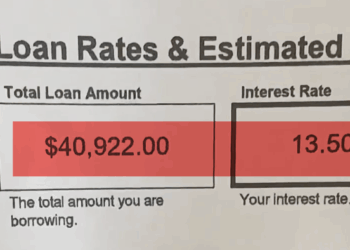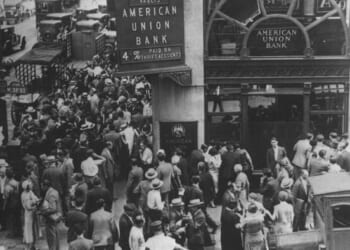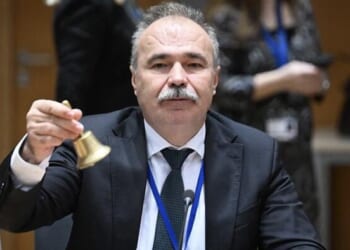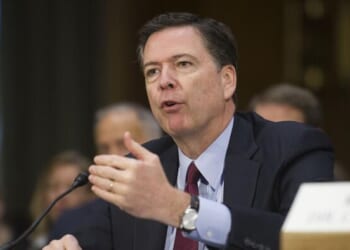Authored by Matthew Piepenburg via VonGreyerz.gold,
I often close public interviews with the recommendation that investors facing an increasingly complex, distorted and landmine-rich economic setting need to focus on being informed rather than emotional.
Free Power
In other words, facts, cycles and patterns matter—in everything from the history of debt cycles and the otherwise “boring” patterns of bond marketsto an ignored template of centralizationwhich always follows bankrupt financial systems.
Being informed offers clarity; being emotional creates fear.
And clarity is both powerful and free.
One does not need millions to feel more empowered in a world otherwise usurping your power with each passing day via the invisible tax of misreported inflation—i.e., open theft through the hidden yet deliberate fiat currency debasement sovereigns employ to inflate away their own criminally negligent bar tab at your expense.
The entire premise of our enterprise of preserving wealth through real money—i.e., precious metals—is built upon such informed thinking.
Trust Your Own Judgement
This does not mean, of course, that being informed means blind conformity to other informed viewpoints—ours or anyone else’s.
I, for example, enjoy debating the dollar/DXY with folks like Brent Johnson or Henrik Zeberg precisely because they are informed disagreements.
In the end, however, we all agree on gold’s penultimate role in preserving real wealth against paper wealth. As I’ve said elsewhere: Today, the case for gold is almost too obvious…
We All See the Cracks
Even more importantly, such informed opinion makes for better strategies and conversations within an economic and geopolitical backdrop which most of us (left or right, rich or poor, black or white, BTC or gold-bugging) would agree is becoming increasingly distorted, dangerous and well, just plain corrupted.
Such corruption is the direct and objective result of the deliberate mismanagement, complexity and dishonesty that underpins a global financial system racing toward a fourth turning whose massive yet not entirely known risks and consequences are playing out with each passing headline.
What Complexity? What Dishonesty?
But what do I mean by deliberate complexity and dishonesty?
As we see below, the most obvious signals can be found within the living case studies of: 1) the not-so-federal “Federal Reserve,” and 2) that other equally grotesque monster hiding in plain sight, namely the global derivatives market.
But before we touch upon these two examples, let me also warn that becoming “informed” comes with a price, typically in the form of deep disillusionment, as the informed are typically a minority crowd.
Melting Laws, Melting Ideas
I know as many lawyer jokes as the next guy, but in truth, nothing I’ve studied (from Plato to Dalio) compares to what I learned in the first year of law school.
Lawyers, after all, make it easy to laugh at, well…the law.
But the very structure and mechanics of our society can be found in the beautiful ideals of a 1L (first-year) legal curriculum.
Constitutional law, for example, grants free society an institutional framework. Criminal Law, in theory at least, lauds justice while punishing those who abuse it. To make that system work, you also need the laws of Civil Procedure. No less important to free citizens is a way to govern ideals of domain, i.e., Property Law.
Finally, and of equal importance, we need to believe and know that citizens, from the governed to the governing, from Wall Street to Main Street, will keep their agreements and honor their promises. That’s Contracts Law.
But sadly, and boy do I mean sadly, we see that these bedrock principles of our core structural and societal laws are, like our fiat dollars, melting before our very closed eyes.
How so?
Well, let’s get back to today’s two case studies: The Federal Reserve and the global derivatives markets.
First: The Fed
I’ve written ad nauseum about the Fed (here, here and elsewhere), and won’t repeat all its numerous sins.
Instead, let’s just stick to the simple crazy and see how our government broke its constitutional contract with its citizens yet paid no criminal price for its clever theft/crime.
In 1913, a cabal of private bankers convinced Woodrow Wilson to make legal a Federal Reserve, which now sits on Constitution Avenue, that is objectively neither “federal,” a “reserve” nor even remotely constitutional.
Yet almost no one understands what it does, how it works or what it destroys.
How the Fed Works…
In simple yet objective terms, the Fed is a private bank which includes 12 regional Federal Reserve Banks, from Richmond to Boston.
These reserve banks, managed by a board of governors, are private corporations whose shareholders are those TBTF commercial banks, which you readers helped bail out in 2008.
As Fed shareholders, these private banks and their unelected CIO’s (Morgan Stanley, JP Morgan, Goldman Sachs etc.) effectively own the Fed, and they receive a 6% dividend from the Fed every year.
Again, not very “federal”, is it?
But it gets crazier.
How the Fed Steals…
If you can actually find a dollar bill, you’ll see that it says “Federal Reserve Note” across the top of its fading paper.
By “Note,” this just means that a dollar is a promise to pay—i.e., it’s credit. An IOU, a debt instrument. It’s no longer backed by anything real—it’s just a (broken) promise to be a store of value.
In 1913, President Wilson, the leader and fiduciary for all US citizens, granted this private bank the power to create as many of those dollars as it wanted. That’s what the Fed does.
But how does the Fed earn/create those dollars?
Literally out of thin air. Money is created with a mouse click out of a computer at the Eccles Building. Yes. Really.
The Fed then lends these magical dollars to the US Treasury Department (via “open market operations”) to pay for Uncle Sam’s ever-expanding deficits.
We, the taxpayers, then pay interest (i.e., a forced profit) to the Fed for those created/lent dollars.
But here’s the rub and the question which is never taught in schools—from high school civics to Wharton MBA programs: To whom does the Fed owe money?
The answer is: To no one.
The Fed, which has the power to create unlimited dollars which it then lends out for interest payments (i.e., profit) to itself, is not beholden to anyone. It’s a private cabal which profits for free while debasing your greenback.
This literally makes its immaculate 1913 conception the greatest wealth and power transfer in the history of our now legally neutered nation, for in 1913, the US gave a private bank its once constitutionally-mandated power(Article 1, Section 8) to make and control our money.
Or to misquote Dire Straits, the Fed gets its “money for nothing and its power for free.”
Meanwhile, and since 1971, that same dollar has lost 99% of its purchasing power when measured against the very gold our now insulted Constitution once (1787) promised its dollar to protect its citizens.
That’s a legislative crime for which our criminal laws have done nothing to redress…
Second: The Global Derivative Crime
Speaking of criminal acts and broken contracts, understanding the basics of derivative (i.e. futures, forward and swap) “contracts” will make you both angry and scared.
“Derivatives” literally “derive” from an underlying asset and are little more than uber-levered paper contracts, which institutions say they use to hedge risk in theory.
In actual practice, however, they are nothing more than betting instruments of massive leverage which profit banks when liquidity and markets are smooth, yet crush economies when liquidity and markets misfire.
Again, I’ve written about the absurd math, danger and crimes of these deliberately complex instruments here and here for those seeking more color and cringe.
For now, let’s keep the complex simple.
Remember 2008?
Most of us, for example, recall the Lehman Brothers’ headlines of 2008. At that time, Lehman was telling the markets in had a clean, $600B balance sheet of matched assets and liabilities.
What Lehman did not say, however, is that it also had levered bets (i.e., derivative contracts) on mostly sub-prime mortgages with over $35T in actual (what the fancy lads call “notional”) exposure in underlying bets on pooled mortgages (assets) it never owned—but just levered/gambled on.
But hey, why worry, mortgages never default? Right?
As soon as the bet on the underlying asset went sideways, Lehman was a corpse carried off the Wall Street battlefield.
Sad?
No, tragic.
Why?
Because all the other Wall Street banks and funds were guilty counterparties to the Lehman trade, which means once one domino fell, the others—from AIG to Citi fell too.
The contagion then went global, and when the dust settled, over $25T in bailout funds (from TARP, the Fed and other global central banks) was needed to prevent a global collapse of over $60T in global (and highly complex) notional derivative exposures.
Whewwww.
No Lessons Learned…
The market must have learned a hard lesson in 2008, right?
After all, the Dodd-Frank regulations kicked in to safeguard better transparency and centralized clearing to prevent such levered timebombs from ever risking the financial system again, right?
Wrong.
Fast-forward to 2025, and the notional value of the global derivatives market has skyrocketed from $60T in 2008 to over $600T today.
Read that last line again.
That $600T exposure is 6X global GDP, and if just 5% of this levered market went sideways, the bar tab would be $30T, which is more than the 2008 crisis and far more than any bailout of central banks could afford today.
The Banking Risk No One Sees
What’s even crazier is that the very banks exposed in 2008 to that derivative madness have increased their derivative bets exponentially (by 10X), and in a concentrated manner that defies belief and screams of risk, which almost no one hears or sees.
Today, only four banks (JP Morgan, Citi, BofA & Goldman) hold 90% of the global derivative exposure. JP Morgan has a $54T notional derivative exposure against only $3.7 in total assets and an equity capital of $300B.
Citi is staring at $48T in notional derivative exposure against $2.4T in total assets and $200B in equity capital. Goldman, in turn, has $47T in notional exposure against $1.6 T in total assets and $120B in equity capital, while BofA is risking $37T of derivative bets against $3.1T in total assets and $280B in equity capital.
Folks, this is madness hiding in plain sight.
Risk Has Never Been Higher
The banks, and the economically clueless in the House of Representatives, however, believe that such “sophisticated players” know how to hedge risk with these instruments.
This is what Larry Summers told Congress years before those same players and deregulated derivatives brought the world to its knees in 2008.
What is not said today is that those very same concentrated banks are all “hedged” (i.e., gambling) on the same trades, signals and “good times.”
This means if markets–from Interest rate volatility, the $600B CMBS trade, tanking European banking shares or sovereign credit defaults to geopolitical black swans–ever go from liquid and smooth to illiquid and bumpy, the risk (inevitability) of another derivative-domino nightmare is exponentially higher today than it ever was in 2008.
By the way, each of those foregoing risks/triggers for a derivative implosion are now making ignored but terrifying moves, from post-2022 rate volatility signals and defaulting commercial loans, to Credit-Suisse-like rumblings at Deutsche Bank and sovereign credit risks from Japan and China to even the USA…
Make Your Own Justice
But where’s the justice? Where’s the criminal laws and civil procedures to punish these well-dressed gamblers masquerading as bankers?
Where’s the constitutional guidance to protect the governed from the mafia-like centralization (and usurpation) of our once free markets and free society by a neo-feudalistic minority/monopoly of corporate centralization over our once idealistic and hopeful nation?
Stated more simply: Where are the laws and ideals I knew as a 1L in law school, all lawyer jokes aside?
Gold, of course, can’t protect me or the rest of us from such dishonesty hiding behind intentional complexity. It can’t alas, do everything.
But at least when it comes to protecting us against paper money, which our governments no longer or even constitutionally respect, at least we can do what our now-ignored Constitution originally recommended by backing our fiat toilet paper with real gold.
In short, we can and must consider becoming our own central bankers, and do for ourselves what the Fed has failed to do for the nation—namely, gold-back our own wealth as Article 1, Section 8 warned centuries ago…
Loading recommendations…


















